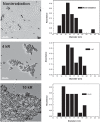Irradiation stability and cytotoxicity of gold nanoparticles for radiotherapy
- PMID: 19774115
- PMCID: PMC2747351
- DOI: 10.2147/ijn.s6723
Irradiation stability and cytotoxicity of gold nanoparticles for radiotherapy
Abstract
Gold nanoparticles are promising as a kind of novel radiosensitizer in radiotherapy. If gold nanoparticles are shown to have good irradiation stability and biocompatibility, they would play an important role in radiotherapy. In this work, we investigated irradiation effects of gold nanoparticles under 2-10 kR gamma irradiation and cytotoxicity of gold nanoparticles with human K562 cells by using Cell Titre-Glo luminescent cell viability assay. The results revealed that gamma irradiation had not induced any obvious instability and size variations in gold nanoparticles. We found that gold nanoparticles showed excellent radiation hardness with an absorbed dose conversation factor of 9.491 rad/R. Meanwhile, the surface plasmon resonance of gold nanoparticles was enhanced obviously after 2-10 kR gamma irradiation. Subsequently, cytotoxicity tests indicated that the extremely high concentration of gold nanoparticles could cause a sharp decrease in K562 cell viability, while the low concentration of gold nanoparticles had no obvious influence on the cell viability. Our results revealed that gold nanoparticles were stable under high-energy ray irradiation and showed concentration-dependent cytotoxicity.
Keywords: colloids; cytotoxicity; gamma ray effects; gold nanoparticles.
Figures






References
-
- Daniel MC, Astruc D. Gold nanoparticles: assembly, supramolecular chemistry, quantum-size-related properties, and applications toward biology, catalysis, and nanotechnology. Chem Rev. 2004;104:293–346. - PubMed
-
- Eustis S, El-Sayed MA. Why gold nanoparticles are more precious than pretty gold: Noble metal surface plasmon resonance and its enhancement of the radiative and nonradiative properties of nanocrystals of different shapes. Chem Soc Rev. 2006;35:209–217. - PubMed
-
- Hu M, Chen J, Li ZY, et al. Gold nanostructures: engineering their plasmonic properties for biomedical applications. Chem Soc Rev. 2006;35:1084–1094. - PubMed
-
- Anker JN, Hall WP, Lyandres O, Shah NC, Zhao J, Van Duyne RP. Biosensing with plasmonic nanosensors. Nat Mater. 2008;7:442–453. - PubMed
-
- Sokolov K, Follen M, Aaron J, et al. Real-time vital optical imaging of precancer using anti-epidermal growth factor receptor antibodies conjugated to gold nanoparticles. Cancer Res. 2003;63:1999–2004. - PubMed
Publication types
MeSH terms
Substances
LinkOut - more resources
Full Text Sources

